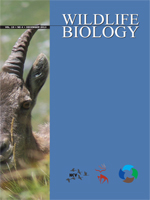A residual population of Amur tigers Panthera tigris altaica probably survives in the eastern Wanda Mountains (EWM) in China, where the main prey species are red deer Cervus elaphus, eastern roe deer Capreolus pygargus and wild boar Sus scrofa ussuricus. We used 53 snow sample plots each containing about 29 km of transects to detect ungulate presence and determined their total density in EWM in 2002 to be 87.9 ± 8.9 kg km−2. We then applied these data to three published models that predict the relationship between tiger density and prey biomass density to obtain three estimates of tiger carrying capacity in EWM. Existing estimates of tiger density suggest that tigers were below carrying capacity estimates. Relationships between prey density and tiger density from 15 studies indicate a threshold prey biomass of 195 kg km−2 (CI: 33-433), below which a tiger population cannot be sustained. We therefore concluded that the EWM population of tigers is in peril. We compared densities between the years 2002 and 2008 using comparable data and found that the EWM populations of the three ungulate prey species all experienced decreases of 40-45%, apparently due to intense poaching. This rapid decline in prey density and pervasive threats to tigers and their prey in the EWM demands immediate and effective protection of ungulate and tiger populations from poaching if tigers are to persist and recover.
How to translate text using browser tools
1 December 2013
Does prey density limit Amur tiger Panthera tigris altaica recovery in northeastern China?
Changzhi Zhang,
Minghai Zhang,
Philip Stott

Wildlife Biology
Vol. 19 • No. 4
December 2013
Vol. 19 • No. 4
December 2013
Amur tiger
Capreolus pygargus
carrying capacity
Cervus elaphus
Panthera tigris altaica
poaching
red deer




